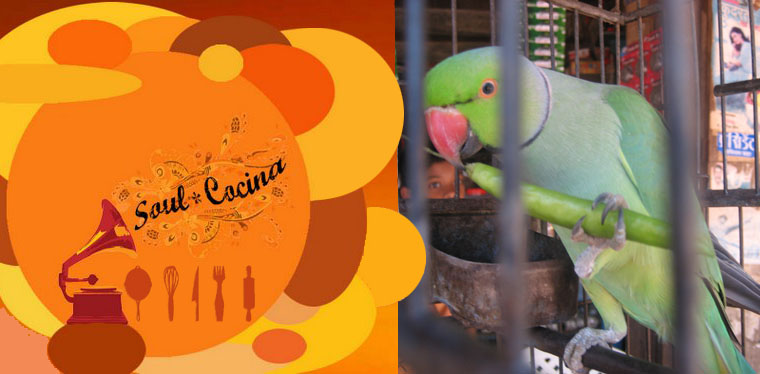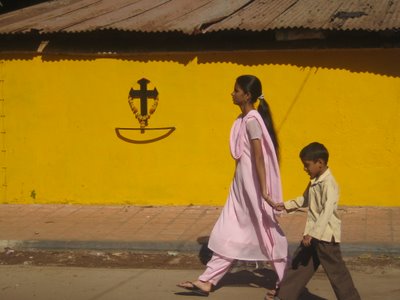 Although Jesus was not born on Christmas, and probably not even in the wintertime, Goa, along with the rest of the Christian world, celebrates his birthday on December 25th. It may seem a little late for a Christma post, but in Goa Christmas celebrations continue until the end of winter break in the begining of January. In the USA christmas time starts in the begining of December and ends shortly after Dec 25, but here, Christmas celebrations start a few days before Dec 25. Many Xmas parties are after Dec 25th in Goa.Christmas is a very festive time in Goa that brings many special dishes to the table. Sans rival is a Goan cake that makes many appearances during the holiday season. It is a cashew cake with sugar icing.
Although Jesus was not born on Christmas, and probably not even in the wintertime, Goa, along with the rest of the Christian world, celebrates his birthday on December 25th. It may seem a little late for a Christma post, but in Goa Christmas celebrations continue until the end of winter break in the begining of January. In the USA christmas time starts in the begining of December and ends shortly after Dec 25, but here, Christmas celebrations start a few days before Dec 25. Many Xmas parties are after Dec 25th in Goa.Christmas is a very festive time in Goa that brings many special dishes to the table. Sans rival is a Goan cake that makes many appearances during the holiday season. It is a cashew cake with sugar icing.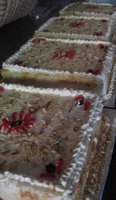 The baker, Raju, at Nostalgia in south Goa baked about 20 sans rival cakes in two days, and each cake has about five layers. Bebinca is another layer cake that takes about 6 hours to cook. Talk about slow food. The coconut batter is baked one layer at a time with a little ghee between each layer until there are 8 to 12 layers. the resulting cake becomes a dark translucent color with layers that peel apart.
The baker, Raju, at Nostalgia in south Goa baked about 20 sans rival cakes in two days, and each cake has about five layers. Bebinca is another layer cake that takes about 6 hours to cook. Talk about slow food. The coconut batter is baked one layer at a time with a little ghee between each layer until there are 8 to 12 layers. the resulting cake becomes a dark translucent color with layers that peel apart. 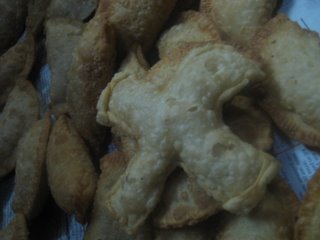
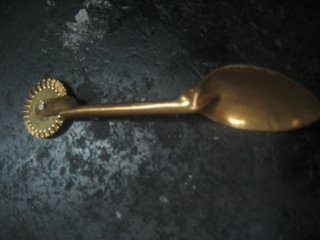 Everyone has there own way of eating bebinca. Another festive Goan classic that Chef Fernando and his team creates for the Christmas season is Dedos De Dama, cashew frangipane coated in sugar caramel. For the Goan parties last week we cut a watermellon in half and stick the dedos de dama (maiden's fingers) onto decorated skewers, which are then dipped into hot caramel (like making crouquembouche) then the skewers are stuck into the watermellon, making a funky spiked dome. Guests pull a stick from the watermellon and enjoy the dedos de dama like lolypops.I also enjoyed making Neuros with the hardcore Goan chefs at Nostalgia. Neuros are addictive sweets that are made for Christmas in Goa. They are fried pastries like empanadas that are filled with semolina and coconut. The first Neuro is shaped into a cross to bless the rest of the batch which are shaped like half moons using a special spoon that has a fluted pastry wheel at one end and a spoon for the filling on the other end. I found some of these spoons in Mapsa for 15 rupees each.
Everyone has there own way of eating bebinca. Another festive Goan classic that Chef Fernando and his team creates for the Christmas season is Dedos De Dama, cashew frangipane coated in sugar caramel. For the Goan parties last week we cut a watermellon in half and stick the dedos de dama (maiden's fingers) onto decorated skewers, which are then dipped into hot caramel (like making crouquembouche) then the skewers are stuck into the watermellon, making a funky spiked dome. Guests pull a stick from the watermellon and enjoy the dedos de dama like lolypops.I also enjoyed making Neuros with the hardcore Goan chefs at Nostalgia. Neuros are addictive sweets that are made for Christmas in Goa. They are fried pastries like empanadas that are filled with semolina and coconut. The first Neuro is shaped into a cross to bless the rest of the batch which are shaped like half moons using a special spoon that has a fluted pastry wheel at one end and a spoon for the filling on the other end. I found some of these spoons in Mapsa for 15 rupees each.
Tune: Spoon by Cut Chemist
Tune: Spoonful Blues by Charley Patton Vasco de Gama arrived in Goa in 1498 to set up a Portuguese colony to control the spice trade since the land routes were cut off by the Ottoman Dynasty. Half a century later the Christian Missionary, St. Francis Xavier, tried to start an inquisition in Goa. The Goan Inquisition started about a decade after his death. His body (most of it) is in a glass couffin in Old Goa at the Basilica of Bom Jésus. It has resisted decay and they say that his fingernails continue to grow. Every ten years his body is displayed to the public and people make a pilgramige to see his corpse.
Vasco de Gama arrived in Goa in 1498 to set up a Portuguese colony to control the spice trade since the land routes were cut off by the Ottoman Dynasty. Half a century later the Christian Missionary, St. Francis Xavier, tried to start an inquisition in Goa. The Goan Inquisition started about a decade after his death. His body (most of it) is in a glass couffin in Old Goa at the Basilica of Bom Jésus. It has resisted decay and they say that his fingernails continue to grow. Every ten years his body is displayed to the public and people make a pilgramige to see his corpse.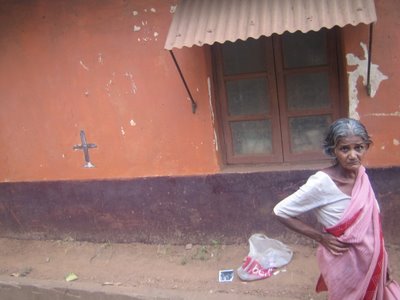 One year a lady from bombay bit off a piece of his fingernail and brought it back to Bombay with her, but when her family found out they made her return it. St Francis Xavier's right arm was sent to the main Jesuit church in Rome where it is on display. His right hand was the hand he used to bless and baptize his converts.
One year a lady from bombay bit off a piece of his fingernail and brought it back to Bombay with her, but when her family found out they made her return it. St Francis Xavier's right arm was sent to the main Jesuit church in Rome where it is on display. His right hand was the hand he used to bless and baptize his converts.
Tune: I Had Me Hands In Me Pocket at the Time by George Formby Senior who was born one hundred years before I was. He colapsed durring the run of a Christmas performance which led to his death a few months later.
Tune: Hands of Fate by Lakim Shabazz
Many Jews who fled the Iberian Inquisition landed in Goa. The Hindu rulers of Kerala helped many Jews escape the Goan Inquisition by allowing them to move to Cochin. They were soon chased out by the Goan Inquisition. By the end of the 16th century, many Hindu Goans had converted to Christianity. It became illegal for Hindus to practice in public, and most temples were destroyed. The Portuguse built churches all over Goa. They outlawed many soulcocina staples, like Hindu instruments, food, and paan. 
My computer is down, so my gospel and Jesus tribute mixes are not available. (anyone with the mixes can email them to me please). So for now, I offer some great tunes about Jesus that I have collected from some of my favorite audioblogs like Moistworks and Wayne and Wax.
Tune: Jesus Gave Me Water by The Five Blind Boys of Mississippi
Tune: Me and Jesus the Pimp in a "79 Granada Last Night by The Coup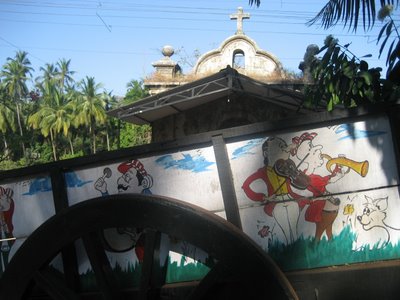
Tune: I Heard The News (Jesus is Coming Again) by Sister Wynona Carr
Tune: Sexy Jesus by Wayne & Wax
Under the Inquisition, Hindu names were also banned. People would take the name of the priest who christianed or baptised them.
Tune: Baptise Me in Wine by Screamin' Jay Hawkins
The Missionaries did allow the recently converted Goans to keep the tradition of the caste system, which convieniently helped to keep control of the people. In 1623 the Pope, Gregory XV passed a decree that allowed all converted Hindus to keep the caste system.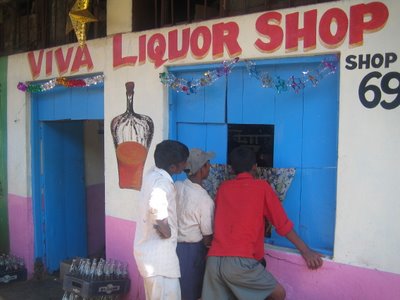 Another aspect of Portuguese culture that has survived in Goa is the love of booze. These kids (above) are lined up outside the Viva Liquor Shop in Panjim on Christmas day.
Another aspect of Portuguese culture that has survived in Goa is the love of booze. These kids (above) are lined up outside the Viva Liquor Shop in Panjim on Christmas day.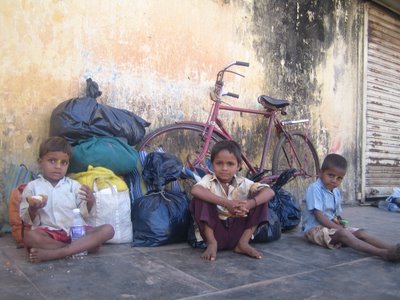 Another part of Portuguese culture that lives on in Goa is the Siesta. These kids decided to stay awake during siesta time near the Panjim market on Christmas day while some of the ladies that sell vegetables at the market decided to take a cat nap.
Another part of Portuguese culture that lives on in Goa is the Siesta. These kids decided to stay awake during siesta time near the Panjim market on Christmas day while some of the ladies that sell vegetables at the market decided to take a cat nap.





There were some Hindu Brahmins that resisted the Portuguese rule that occupied the islands of Divar and Chorao, the two largest islands on the Mandovi River. They gaurded the islands against Portuguese invasion and even raided some of the Portuguese garrisons along the river. The Indo-Portuguese monk, Fr. José Custódio de Faria, (AKA Abbé Faria) was one of the leaders of a revolt against Portuguese rule in Goa in the Conspiracy Of The Pintos in 1787. Abbé Faria was one of the pioneers of the scientific study of hypnotism.
Tune: The Hypnotic by The Roots
I can't share the recipe for Chef Fernandos nueros, which are filled with roasted semolina and coconut and fragrant with cardamon. But I will share another popular versian of the Christmass Nuero. The dough for the outer crust is made from boiled sweet potatoes. This recipe comes from a book of Goan Saraswat Hindu recipes called Ishtann that I picked up in Goa.
Sweet Potato Nueros
4-5 sweet potatoes, boiled then cooled to room temp
1 1/4 cup grated coconut
3/4 cup Goan jaggery (jaggery from coconut palm)
8-10 cashewnuts, crushed
a pinch of cardamom powder
salt to taste
ghee
Put potatoes in a stock pot, cover with enough water and cook until done (they should be mushy to the touch). Drain and let cool.
Mix grated coconut, cashew pieces, salt and cardamom powder. Add jaggery and cook on moderate heat until the mixture is thoroughly combined. Keep aside.
Peel the potatoes, mash them and form a dough. Flatten into circles with your fingers. Spoon a little filling on one side and fold over into a crescent. Make ridges with a fork, press lightly and keep aside.
Heat a griddle on moderate heat. Fry the nuero using ghee until GBD. Turn over gently and fry on the other side.
Drizzle with ghee and serve hot.
Monday, December 25, 2006
Christmas in Goa
Thursday, December 07, 2006
Palmiers from a Soul Ranchikud
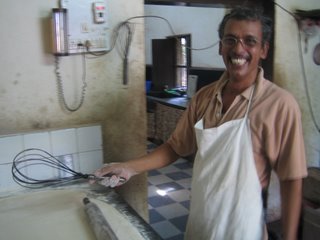 This is a real soul cocina, that's soul kitchen, or soul rasoi in Hindi, or in Konkani soul ranchikud. Ranchi means to cook, kud means room. Jila Bakery in Raia, South Goa near Margao has a real soul ranchikud. They make everything by hand, the old fashioned way with real ingredients. No commercial mixes, no dough sheeters, no kitchen aid mixers, no hobart mixers, no thermometers, no substitutes, no joke.
This is a real soul cocina, that's soul kitchen, or soul rasoi in Hindi, or in Konkani soul ranchikud. Ranchi means to cook, kud means room. Jila Bakery in Raia, South Goa near Margao has a real soul ranchikud. They make everything by hand, the old fashioned way with real ingredients. No commercial mixes, no dough sheeters, no kitchen aid mixers, no hobart mixers, no thermometers, no substitutes, no joke. Everything is made by hand, as you can see from the photos of these two happy bakers who happen to be brothers. The pots are all handmade copper pots that the family made. They built their own wood burning, coal oven. There are no temperature gauges, they know when the temperature is right for there eclaires, macaroons (melt aways), and palmiers. They cook sugar for fondant by eye. The gas and electric company came to the bakery to ask how they could provide so many tastey treats to Goan households and restaurants with such a low energy bill. The bakers showed them their tools. Wooden spoons, copper pots, hand whisks, and a brick wood fired oven. Electricity is only used for a few fans and lightbulbs in the bakery and a few common electrical things in the home part of the home-bakery.
Everything is made by hand, as you can see from the photos of these two happy bakers who happen to be brothers. The pots are all handmade copper pots that the family made. They built their own wood burning, coal oven. There are no temperature gauges, they know when the temperature is right for there eclaires, macaroons (melt aways), and palmiers. They cook sugar for fondant by eye. The gas and electric company came to the bakery to ask how they could provide so many tastey treats to Goan households and restaurants with such a low energy bill. The bakers showed them their tools. Wooden spoons, copper pots, hand whisks, and a brick wood fired oven. Electricity is only used for a few fans and lightbulbs in the bakery and a few common electrical things in the home part of the home-bakery. The bakery was started 30 years ago by a trained and accomplished baker and his family. The baker was a top pastry chef at the Taj Hotel in Bombay before returning to Goa to open his shop, Jila bakery. When the chef passed away his sons continued to carry on the tradition with the same love and skill. I just happened to find Jila bakery on my way to meet with the famous Goan Chef Fernando of Nostalgia Restaurant, also in Raia, South Goa. I stopped, on my way to Nostalgia, at a jam shop to see if I could learn how they make and package the jams. I was hoping for another lesson in jams and canning to add to what I learned last year at June Taylor's marmelade class, where we learned to extract pectin from lemons. Or maybe pick up some canning secrets to add to what I have learned with Sara Ko. Unfortunately, they didn't let me in behind the scenes (the owner was not there), but they directed me to "Goa's most famous bakery", which was just around the corner on a peaceful road behind some flowering trees. I was welcomed in as soon as I arrived and the lady who greeted me gave me some samples of some sweets. They were happy to show me the bakery and they even showed me how to make their famous palmiers.
The bakery was started 30 years ago by a trained and accomplished baker and his family. The baker was a top pastry chef at the Taj Hotel in Bombay before returning to Goa to open his shop, Jila bakery. When the chef passed away his sons continued to carry on the tradition with the same love and skill. I just happened to find Jila bakery on my way to meet with the famous Goan Chef Fernando of Nostalgia Restaurant, also in Raia, South Goa. I stopped, on my way to Nostalgia, at a jam shop to see if I could learn how they make and package the jams. I was hoping for another lesson in jams and canning to add to what I learned last year at June Taylor's marmelade class, where we learned to extract pectin from lemons. Or maybe pick up some canning secrets to add to what I have learned with Sara Ko. Unfortunately, they didn't let me in behind the scenes (the owner was not there), but they directed me to "Goa's most famous bakery", which was just around the corner on a peaceful road behind some flowering trees. I was welcomed in as soon as I arrived and the lady who greeted me gave me some samples of some sweets. They were happy to show me the bakery and they even showed me how to make their famous palmiers. 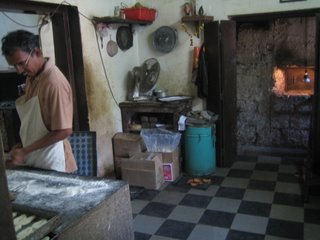 I made a little video of the palmier demo with Konkani music for the soundtrack. One of the two brothers is also a musician and he gives music lessons at the home bakery. They showed me a video of a news piece about Goan food that was hosted by legendary cartoonist and comedian Mario Miranda. Mario visited the bakery on the show and interviewed the family. He even got some footage of the musician brother teaching violin. I do not remember the bakers'names, but I will be bake to Jila bakery soon. Slow cooking in Goa.
I made a little video of the palmier demo with Konkani music for the soundtrack. One of the two brothers is also a musician and he gives music lessons at the home bakery. They showed me a video of a news piece about Goan food that was hosted by legendary cartoonist and comedian Mario Miranda. Mario visited the bakery on the show and interviewed the family. He even got some footage of the musician brother teaching violin. I do not remember the bakers'names, but I will be bake to Jila bakery soon. Slow cooking in Goa.

Video: Palmier Demo at Jila BakeryA Soulcocina Motion Picture Presentation
Tune: bakershop Boogie by Willie Nix
Saturday, December 02, 2006
Mapusa Market
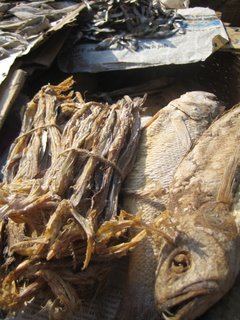 The Friday market in Mapusa is the best market I have found in Goa. The Panjim Market is great for everyday shopping, but the Mapusa market has everything the Panjim market has and more. The market also caters to farmers with agricultural products like seeds and farm tools. There is lots of dried fish, dried shrimp, makarel, and Bombay duck (bombil or bummalo). The first time I tried Bombay duck was when Major Marfatia took us to a Parsi restaurant last year in Mumbai called Britanias. Ever since then, Bombay duck has been my favorite lizardfish. You can also find fresh Bombay duck at the Mapusa market, as well as pomfret, rockfish, kingfish, clams, and lots of other fresh and dried seafood.
The Friday market in Mapusa is the best market I have found in Goa. The Panjim Market is great for everyday shopping, but the Mapusa market has everything the Panjim market has and more. The market also caters to farmers with agricultural products like seeds and farm tools. There is lots of dried fish, dried shrimp, makarel, and Bombay duck (bombil or bummalo). The first time I tried Bombay duck was when Major Marfatia took us to a Parsi restaurant last year in Mumbai called Britanias. Ever since then, Bombay duck has been my favorite lizardfish. You can also find fresh Bombay duck at the Mapusa market, as well as pomfret, rockfish, kingfish, clams, and lots of other fresh and dried seafood.
The long thin dried fish on the left is Bombay duck
Tune: Bombay duck by The Ventures
Mapusa comes from the Konkani words maap, meaning "measurement", and sa, meaning "to fill". The market dates back to as early as 1850. There are some curious antique shoppes near the market. I saw some old gramaphones for sale so I started my hunt for old Konkani and Hindi records. There was one shopkeeper that kept some old records in a pile on the ground under an antique cabinet. They were Portuguese and Hindi records that seemed interesting (some Mohammed Rafi and Kishore Kumar 78's) but they were all scratched and cracked. The Indian climate really takes its toll on old records. Although I didn't score any film scores on vinyl in Mapusa, I did get some great tracks back at home in Dona Paula. Instead of the old fashioned way, these songs came to me via bluetooth from a friend's cell phone to my laptop. Cell phones are used in India even more than in the US, if you can believe that. SMS (text message) is one of the most common forms of communication in India. So here are some Hindi film classics that were bluetoothed to my computer.
Tune: Khoya Khoya Chaand by Mohammed Rafi
Tune: Ek Ladki Bheegi Bhaagi Si by Kishore Kumar The best bread in Goa is baked the old fashioned way. Without any preservatives or dough conditioners. Artisian pao is everywhere in Goa and is prefered to the commercially packaged bread. There are many pao bakeries scattered across Goa and guys ride around on bicycles with big baskets selling poa door to door and on the street. There are a few bakeries that bring their fresh baked goods to the Mapusa market.
The best bread in Goa is baked the old fashioned way. Without any preservatives or dough conditioners. Artisian pao is everywhere in Goa and is prefered to the commercially packaged bread. There are many pao bakeries scattered across Goa and guys ride around on bicycles with big baskets selling poa door to door and on the street. There are a few bakeries that bring their fresh baked goods to the Mapusa market.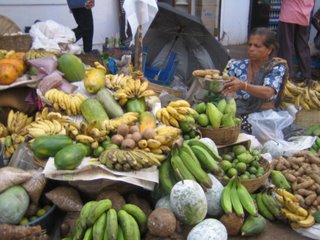
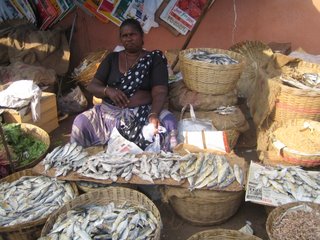 More dried fish.
More dried fish.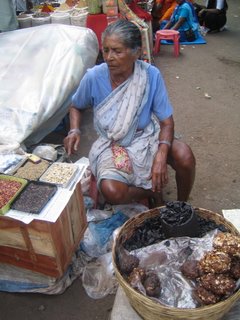 Kokum and tamarind (two ingredients in Ambot Tik.
Kokum and tamarind (two ingredients in Ambot Tik.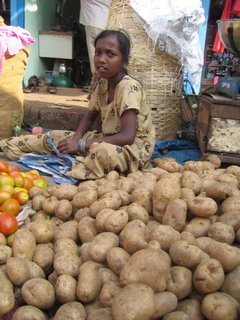
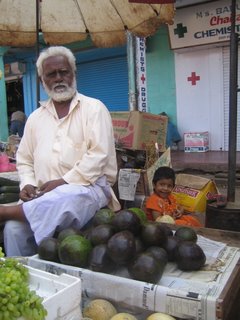 Avacados in India are much larger than the hass avacados we eat in California. They are even bigger than the Florida avacados. Quiet frankly I have never tasted an avacado in India (yet) that was nearly as good as any avacado I have tried in US or Mexico. This guy said these avacados came from Tamil Nadu.
Avacados in India are much larger than the hass avacados we eat in California. They are even bigger than the Florida avacados. Quiet frankly I have never tasted an avacado in India (yet) that was nearly as good as any avacado I have tried in US or Mexico. This guy said these avacados came from Tamil Nadu.
here is some Konkani music from the 1960's and 70's
Tune: Cathrina by Helen D'Cruz and Henry D'Soaza
Tune: Corun Cantaram by Lorna
Tune: Sezari by Helen D'Cruz and Henry D'Soaza
Tune: sorga Rajeant also by Lorna
Tune: Swapan Go Fantyechem by Hemant kumar and Helen D'Cruz
Tune: Taxiwala by Jerome Desouza and chorus
Tune: Yeo Baile Yeo also by Lorna
Tune: Nach maga nach by Jerome Desouza and Lourdes Colaco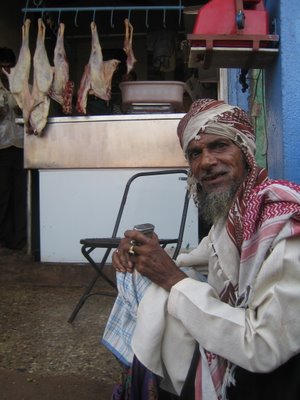 Tune: Love Mi Hafi Get (Nannygoat) by Cutty Rands and Beres Hammond
Tune: Love Mi Hafi Get (Nannygoat) by Cutty Rands and Beres Hammond
The easygoan lifestyle reminds me of the caribbean. Goat is used in many Indian kitchens, and it is often served on festive occassions. After slavery was abolished in Jamaica in the 1830's Indian and Chinese workers were brought to the island to work the sugar cane fields under the indentured labor system. The India laborers brought the recipe for goat curry to Jamaica where it is now a popular festive dish, they also brought ganja and dreadlocks.
Tune: Dreadlocks inna tenament by Jacob Miller
You can see young Jacob Miller sing this song in the film The Rockers You can also see him pull a knife on a guy over a chicken leg in the film. If it was Goan chicken cafreal, I would have done the same thing.
Saturday, November 11, 2006
Snow Flower

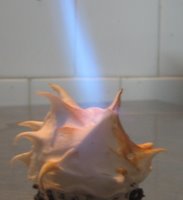 We have been working on a lot of frozen desserts and chocolate desserts at ACE and Cidade de Goa. While studying chocolate, the students at ACE were interested in the way that the Aztecs and Mayans first consumed chocolate as a beverage with cilies and spice. We made a baked Alaska with chile flavored chocolate on a chocolate cake covered with cinnamon meringue. The chocolate used in India is very sweet. I wanted to introduce the students to a more bitter, pure chocolate flavor to use for our creation. I brought some chocolates from San Francisco to Goa for the purpose of holding chocolate tastings for Indian chefs, culinary students and gastronomic enthusiasts. I brought mostly plain dark chocolate and a few flavored chocolates like chocolate and chile pepper, chocolate with coffee and cocoa nibs, and chocolate flavored with absinthe.
We have been working on a lot of frozen desserts and chocolate desserts at ACE and Cidade de Goa. While studying chocolate, the students at ACE were interested in the way that the Aztecs and Mayans first consumed chocolate as a beverage with cilies and spice. We made a baked Alaska with chile flavored chocolate on a chocolate cake covered with cinnamon meringue. The chocolate used in India is very sweet. I wanted to introduce the students to a more bitter, pure chocolate flavor to use for our creation. I brought some chocolates from San Francisco to Goa for the purpose of holding chocolate tastings for Indian chefs, culinary students and gastronomic enthusiasts. I brought mostly plain dark chocolate and a few flavored chocolates like chocolate and chile pepper, chocolate with coffee and cocoa nibs, and chocolate flavored with absinthe. 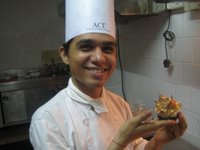 I brought Scharffen Berger Jamaica ā l'ancienne and 68% Cacao Kumasi Sambirano chocolate bars, some estate grown, vintage Valhrona chocolates, some chocolate I picked up in Paris, and a few more kilos of different types of chocolate. We used a combination of some of these chocolates for our Baked Aztec. We came up with a few different names for this creation that was modeled after something I once made that was called the Taj Mahal. We finally came up with Snow Flower.
I brought Scharffen Berger Jamaica ā l'ancienne and 68% Cacao Kumasi Sambirano chocolate bars, some estate grown, vintage Valhrona chocolates, some chocolate I picked up in Paris, and a few more kilos of different types of chocolate. We used a combination of some of these chocolates for our Baked Aztec. We came up with a few different names for this creation that was modeled after something I once made that was called the Taj Mahal. We finally came up with Snow Flower.
tune: Snow Flower by Ananda Shankar from his 1971 self titled album.
Saturday, November 04, 2006
Utterly Butterly Delicious

Dabeli and "Indian Pizzas" in Mumbai. These Indian 'za's and subs are way tastier than these and these. Probably because this cook grills his tomatoes for a long time before adding the rest of the ingredients, then tops off his Bombay hoaggies and pies with more chopped tomatoes, this time uncooked. Not to mention the fresh bread that is delivered to his stall every morning by the bicycle pao wala. He also said he uses a good dabeli masala he gets from his brother. Also, he grills the bread w/ Amul butter. The filling is like a slightly sweet version of Pao Bhaji.
Here is a recipe I adapted from a great little cookbook I picked up in Bombay called "Street Foods of India" to create the dabeli filling.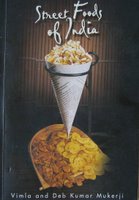 1 KG Potatoes, boiled,peeled, diced
1 KG Potatoes, boiled,peeled, diced
1 C Desi Ghee
20 g Sugar
25 ml Tamarind pulp
25 g Pomegranate seed
25 g Chopped roasted peanuts
400 g Tomatoes, diced
120 g Onion, finely chopped
6 Green chiles, chopped fine
1 1/2 T Ginger, minced
1 1/2 t Tumeric powder
1 t Red chile powder
2t Garlic paste
2t Ginger paste
1 C Water
3/4 C Amul butter (or annato butter)
3t Pao Bhaji Masala (recipe below)
1 C Cilantro, chopped
3 T Lemon Juice
12 Bread Rolls (Pao), cut horizontally
-Heat ghee in a tawa or heavy bottomed frying pan. Fry tomatoes for 3-4 minutes over med heat until the juices reduce and flavors concentrate. Add onions, green chiles, minced ginger and tumeric powder. Stir fry for 4-5 minutes over medium heat.
-Add Potatoes, red chile powder and plenty of salt. Continue to cook over low heat mashing and stirring for 6-7 minutes.
-Add the garlic and ginger pastes, diluted in 1 C water.
-Add masala powder, cilantro and lemon juice. Stir well.
- Coat the bread roll halves with Amul butter and a little garlic paste and place, face down on the griddle to lightly brown.
*Pao Bhaji Masala
Red chili powder 1.5 tsp
Coriander powder 2 tsp
Turmeric powder 1/4 tsp
Garam masala 1 tsp
Cumin (jeera)seeds 1/2 tsp
Amchur (mango powder) 1 tsp
Cloves, 5
Hing (Asafoateda), 1 small grain or powder
Black Salt pinch
Salt to taste
Toast Cumin seeds and grind to powder with cloves. Mix together all spices Tomatoes grilling for pao bhaji at Chowpatty Beach, Mumbai
Tomatoes grilling for pao bhaji at Chowpatty Beach, Mumbai
Meet Amul's mascot, the Utterly Butterly Amul Girl, famous for her witty comments on current affairs across the globe. 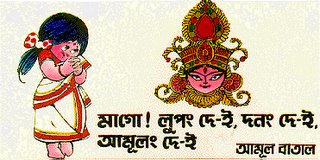
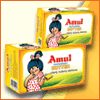 The Amul company started as a cooperative of dairy farmers from the Kheda District of Gujrat in 1946 in an attempt to eliminate the middleman and ensure that profits go directly to the farmers. The co-op is now owned by over 2 million individual dairy farmers in Gujrat. This system ensures small scale production while enabling the farmers to market and distribute collectively.
The Amul company started as a cooperative of dairy farmers from the Kheda District of Gujrat in 1946 in an attempt to eliminate the middleman and ensure that profits go directly to the farmers. The co-op is now owned by over 2 million individual dairy farmers in Gujrat. This system ensures small scale production while enabling the farmers to market and distribute collectively.
Tune: Butter by A Tribe Called Quest
Tuesday, October 31, 2006
Aloo Anarkali


Aloo Anarkali
Potato Cups:
500g potatoes, peeled and cut into little potato cups, then boiled in turmeric water
Filling:
250 g mashed potatoes, inluding the holes of the potato cups
125 g chaana dal, soaked overnight, boiled until al dente
2 Tablespoons shai jeera (royal or black cumin seeds)
1 Tablespoon mustard seeds
150g fresh pomegranate seeds
50 ml lemon juice
2 teaspoons chaat masala
2 green chillis, finely chopped
salt to taste
1/2 bunch fresh mint
1/2 bunch fresh coriander (cilantro)
50 g dried candied cherries, chopped fine
Toast cumin seeds and mustard seeds. Combine all filling ingredients and stuff into potato cups. Roast until hot and enjoy as a snack with tamarind chutney, or finish with a red chile gravy and yogurt to serve as a side dish.
Anarkali means pomegranate blossom. The emperor Jehangir, son of Akbar, had a love affair with a slave when he was the Prince (Salim). She was called Anarkali because of her striking beauty.
A play was written by imtiaz Ali Taj in 1923 called Anarkali
Here is a translation of one of the great scenes of the play which was origionally in Urdu. In the movie Mughal-e-Azam (1960), also based on the story of Anarkali and Prince Salim, this scene was filmed in color in the Hall of Mirrors (the Shish Mahal of the Lahore Fort). The rest of the film was shot mostly in black and white so this scene is even more dramatic. It is a classic Bollywood song and dance number where Anarkali (the voice is actually 24 year old Lata Mangeshkar) sings and dances for the king. But in real life the Shish Mahal had not been built durring the king's lifetime. His grandson built the hall of mirrors in 1631. Ustad Bade Ghulam Ali Khan sang a few songs in Mughal-e-Azam. He was one of the most renowned classical singers of his time. He charged 25,000 rupees per song when famous bollywood singers like Lata were earning less than 500 rupees per song.
Download the soundtrack to Mughal-E-Azam here.
The film Loves of a Mughal Prince (1928) was also based on the same tale Tune: Yeh Zindagi Usiki Hai from the film Anarkali (1953) sung by Lata Mangeshkar
Tune: Yeh Zindagi Usiki Hai from the film Anarkali (1953) sung by Lata Mangeshkar
Tune: Aaja Ab To Aaja also from Anarkali.
.
Louis Armstrong claimed to be born the same year as Imtiaz Ali Taj, 1900. But Satchmo was actually born one year later in 1901. Louis also died one year after Imtiaz Ali Taj was shot dead in 1970. Being from New Orleans, Satchmo played some festive funeral music.
Tune: Garden of Four Trees (1970) by Explosions feat. Juanita Brooks
Tune: Handa Wanda (1970) by Bo Dollis & The Wild Magnolias
Tune: Question (1971) by Bobby Powell
Tune: Baby (1971) by Os Mutantes
Tune: Purity Brigade (1900) by Edna May from the theatrical play The Belle of New York
Hear more of Little Edna May’s turn of the century recordings here.
Tune: Rocking Chair by Louis Armstrong
In the end, legend has it, Anarkali was burried alive in the walls of the palace.
Tune: Qeej Nqug Rooj (Lao Funeral Music) from The Music of the Hmong People of Laos.
Friday, October 27, 2006
Guava
 When I bought a guava from this guy he sliced it up and squeezed lime over it and sprinkled it with chili powder. It was too good.
When I bought a guava from this guy he sliced it up and squeezed lime over it and sprinkled it with chili powder. It was too good.
Tune: The Pessimist Valley of the Guava is a mash up of M.I.A.'s "URAQT" vs Bob Marley's "Guava Jelly" vs Mylo's "Valley of the Dolls" mixed by The Pessimisr
Saved by the Bhel
 Bhel puri wrapped in a recycled paper cone from a street vender in Bombay.
Bhel puri wrapped in a recycled paper cone from a street vender in Bombay.
Tune: Disco Belle Inna Computer Style Mix from computerstyle.org starts out with Eek a Mouse's classic tune Anarexol and then moves into Junior Gong, Bounty Killa, and present day Eek a Mouse tearing up the tune Khaki Suit. The mix continues on for more than half an hour of vintage and modern dancehall classics.
Tune: Ponton La Belle by Kékélé, a Congolese rumba band.
Tune: Belle by Al Green
Tune: Tikela Nga Mobali by Orchestre Bella Bella Pick up one of there CD's here.
I discovered two of these tunes by way of Benn Loxo Du Taccu check out the site to discover more classic and new African hits and obscurities. Kids enjoying a packaged snack in the Bombay sun. There are so many plastic packaged snacks sold on the streets of Bombay. Lots of small tiny packages of little treats. Chai used to be served in biodegradable clay cups. Now most chai on the street is served in little plastic cups. There is plastic everywhere on the street and in the sea along the coasts.
Kids enjoying a packaged snack in the Bombay sun. There are so many plastic packaged snacks sold on the streets of Bombay. Lots of small tiny packages of little treats. Chai used to be served in biodegradable clay cups. Now most chai on the street is served in little plastic cups. There is plastic everywhere on the street and in the sea along the coasts.
Tune: Plastic Reggae Dancehall Mix by Black Plastic Magic with tunes by Fantan Mojah, Tall T & The Touchers, IniKamoze, Ken Boothe, Sizzla, Anthony B, Lee Perry, Bob Marley, Cedric Brooks, and Peter Tosh
Greenpeace India
Thursday, October 26, 2006
Diwali
 A young pastry chef in Bombay offers up a taste of some fresh badam halwa for Diwali.
A young pastry chef in Bombay offers up a taste of some fresh badam halwa for Diwali. After a night of non-stop, ear shattering diwali firecrackers, these Bombayites take it easy
After a night of non-stop, ear shattering diwali firecrackers, these Bombayites take it easy
Tune: Sweet Thang by Shuggie Otis, son of Johnny Otis from the LP Inspiration Information is a nice song to take it easy to.
Tune: Take it Easy by The Fugees
Long Dosa
 Paper Sada Dosa at Legends of Bombay in Panjim, Goa the night before our trip to Bombay.
Paper Sada Dosa at Legends of Bombay in Panjim, Goa the night before our trip to Bombay.
Tune: How Long Blues by Count Basie and Leroy Carr from the box set Tibute to Black Entertainers
Tune: So Long by Little Miss Cornshucks (Mildred Cummings)
Tune: Long Live The Kane by Big Daddy Kane
Tune: Long Time by Sergent Garcia
